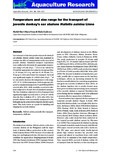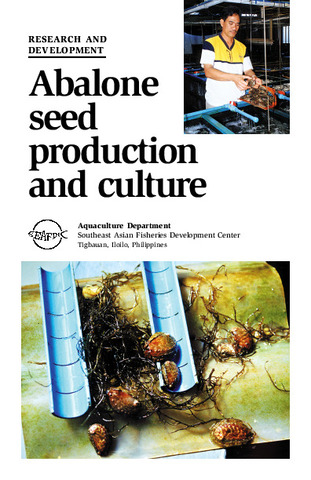Temperature and size range for the transport of juvenile donkey's ear abalone Haliotis asinina Linne
- Global styles
- MLA
- Vancouver
- Elsevier - Harvard
- APA
- Help

View/Open
Date
2011Page views
2,399ASFA keyword
AGROVOC keyword
Metadata
Show full item recordCited times in Scopus
- Citations
- CrossRef - Citation Indexes: 5
- Policy Citation - Policy Citations: 1
- Scopus - Citation Indexes: 12
- Captures
- Mendeley - Readers: 14
Share
Abstract
Live transport of hatchery-produced juvenile donkey's ear abalone Haliotis asinina Linne was examined to evaluate the effect of transportation on the survival of juvenile abalone. Simulated transport experiments were conducted to determine the appropriate temperature using 5, 10 and 20 g L−1 of ice to air volume for 8 h and the appropriate size using two size groups (Size A, 15–20 mm, 0.5–1.3 g, and Size B, 30–35 mm, 5.3–8.5 g) up to 24-h out-of-water live transport. Survival was significantly higher (P<0.001) when 10 g L−1 of ice was used to decrease the temperature to the range of 17–23 °C. At this temperature, both size groups subjected to simulated transport for 8 and 10 h had 100% survival after 48 h, while mortality occurred in abalones subjected to 16 and 24 h of simulated transport. The Size B abalone subjected to 24 h of transport had significantly higher survival (64.4 ± 2.9%) (P<0.001) than the Size A abalone (5.5 ± 1.6%) after 48 h. Live juvenile abalone were successfully transported to the field applying the protocols developed in the lab experiment. This study serves as a guide for handling and shipping live juvenile abalone.
Suggested Citation
Buen-Ursua, S. M. A., & Ludevese, G. (2011). Temperature and size range for the transport of juvenile donkey's ear abalone Haliotis asinina Linne. Aquaculture Research , 42(8), 1206-1213. https://doi.org/10.1111/j.1365-2109.2010.02712.x
Type
ArticleISSN
1365-2109Collections
- Journal Articles [1249]
Related items
Showing items related by title, author, creator and subject.
-
Evolution of genome size within the genus Haliotis (Vetigastropoda: Haliotidae)
Adachi, Kenta; Arai, Katsutoshi; de la Peña, Milagros R.; Moriyama, Shunsuke; Okumura, Sei-Ichi (National Shellfisheries Association, 2018)Genome size (C-value) and the percentage of adenine and thymine nucleotides in the genome (AT content) are fundamental characteristics of every species, and very important parameters in molecular cytogenetic and phylogenic ... -
Abalone seed production and culture
Unknown author (Aquaculture Department, Southeast Asian Fisheries Development Center, 2000)Details the research conducted at AQD for the tropical abalone Haliotis asinina. AQD has developed the rudiments of a hatchery protocol. -
Evaluation of post-release behavior, recapture, and growth rates of hatchery-reared abalone Haliotis asinina released in Sagay Marine Reserve, Philippines
Lebata-Ramos, Ma. Junemie Hazel ; Doyola-Solis, Ellen Flor C.; Abrogueña, Jeff Bogart R.; Ogata, Hiroshi; Sumbing, Joemel G.; Sibonga, Rema
; Doyola-Solis, Ellen Flor C.; Abrogueña, Jeff Bogart R.; Ogata, Hiroshi; Sumbing, Joemel G.; Sibonga, Rema  (Taylor & Francis, 2013)
The lucrative returns brought by abalone fisheries have caused overexploitation and decline of the wild population. In the Philippines, the Aquaculture Department of the Southeast Asian Fisheries Development Center has ...
(Taylor & Francis, 2013)
The lucrative returns brought by abalone fisheries have caused overexploitation and decline of the wild population. In the Philippines, the Aquaculture Department of the Southeast Asian Fisheries Development Center has ...





